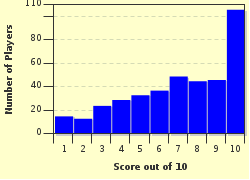Quiz Answer Key and Fun Facts
1. In what year did the Rwandan genocide take place?
2. The countries around Rwanda have all played a part in its politics, including the genocide. Which of the following is a correct list of the countries bordering Rwanda?
3. About how many people were killed in the Rwandan genocide?
4. The series of events that led to Rwanda's genocide was initiated by the assassination of Rwanda's president. Who was this president?
5. What are the two main ethnic groups in Rwanda?
6. One particular event that occurred before the Rwanda genocide is generally considered to be responsible for American inaction in Rwanda. What was it?
7. Which European former colonial power has been accused of being complicit in the genocide?
8. Who commanded the United Nations military forces in Rwanda before and during the genocide?
9. About how long did the Rwandan genocide last?
10. Which of these did the perpetrators of the Rwandan genocide use in order to organize the genocide?
Source: Author
Powderwhite
This quiz was reviewed by FunTrivia editor
bloomsby before going online.
Any errors found in FunTrivia content are routinely corrected through our feedback system.

